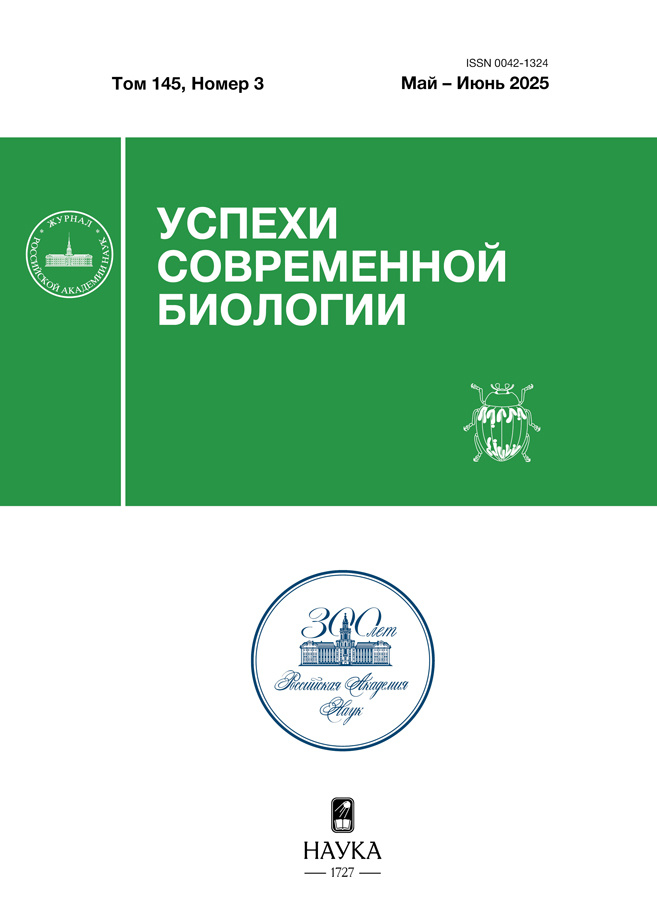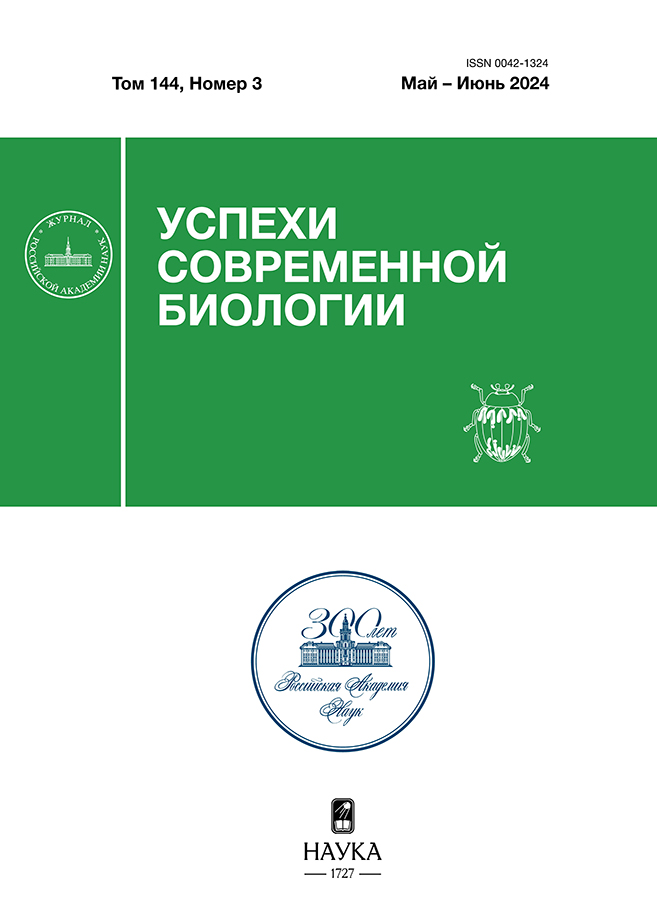Структура и морфогенетические свойства коллагеновых матриц, полученных из соединительнотканных оболочек паравертебральных сухожилий
- Авторы: Гайдаш А.А.1, Кулак А.И.1, Крутько В.К.1, Блинова М.И.2, Мусская О.Н.1, Александрова С.А.2, Скроцкая К.В.3, Кульчицкий В.А.4
-
Учреждения:
- Институт общей и неорганической химии Национальной академии наук Беларуси
- Институт цитологии Российской академии наук
- Научно-исследовательский институт физико-химических проблем Белорусского государственного университета
- Институт физиологии Национальной академии наук Беларуси
- Выпуск: Том 144, № 3 (2024)
- Страницы: 265-290
- Раздел: Статьи
- Статья получена: 02.02.2025
- Статья опубликована: 18.12.2024
- URL: https://cardiosomatics.ru/0042-1324/article/view/653198
- DOI: https://doi.org/10.31857/S0042132424030024
- EDN: https://elibrary.ru/PSCJEW
- ID: 653198
Цитировать
Полный текст
Аннотация
Изучены морфогенетические свойства коллагенового геля, полученного ацетатной экстракцией из соединительнотканных оболочек (перитенонов) паравертебральных сухожилий крыс Вистар. Гель использовали в качестве подложки при культивировании in vitro совместно с мезенхимальными стромальными клетками в течение 14 сут в ростовой и остеогенной инкубационных средах. Установлено, что коллагеновый каркас перитеноновой подложки приобретает прочность за счет увеличения связности фибриллярных узлов и структурирован с формированием пластинчатых и клубковых образований. Сесамовидные глобулы, проникающие в подложку из исходного перитенонового геля, инертны в ходе культивирования в ростовой среде, а в остеогенной – проявляют повышенную способность к структурированию кальцийфосфатов. Формирование клеточно-опосредованных структур происходит по направлениям фибро-, тендо-, лигаменто- и остеогенной дифференцировок. Фиброгенное направление обеспечивает коллагеновым материалам структурирующийся каркас; теногенное – формирование сухожилий эмбрионального типа по механизму латеральной сборки коллагеновых субфибрилл на поверхностях клеток и их автономизацию в виде зачатков сухожильных нитей; лигаментогенное – структурирование коллагеновых лент, ассоциированных с клубками и эластическими волокнами; остеогенное – образование ламеллярных, трабекулоподобных и узелковых остеоидных структур путем внутримембранозной оссификации, сопровождающейся активацией щелочной фосфатазы и минерализации. Формирование предикторов энтез – организация комиссур между механически разнофазными компонентами остеоидных структур и каркаса. Разработана классификация таксономических форм и предложена гипотеза о роли эволюционных инструментов в структурировании коллагенового каркаса в тканевых культурах in vitro.
Полный текст
Об авторах
А. А. Гайдаш
Институт общей и неорганической химии Национальной академии наук Беларуси
Автор, ответственный за переписку.
Email: algaidashspb@gmail.com
Белоруссия, Минск
А. И. Кулак
Институт общей и неорганической химии Национальной академии наук Беларуси
Email: algaidashspb@gmail.com
Белоруссия, Минск
В. К. Крутько
Институт общей и неорганической химии Национальной академии наук Беларуси
Email: suber@igic.bas-net.by
Белоруссия, Минск
М. И. Блинова
Институт цитологии Российской академии наук
Email: algaidashspb@gmail.com
Россия, Санкт-Петербург
О. Н. Мусская
Институт общей и неорганической химии Национальной академии наук Беларуси
Email: algaidashspb@gmail.com
Белоруссия, Минск
С. А. Александрова
Институт цитологии Российской академии наук
Email: algaidashspb@gmail.com
Россия, Санкт-Петербург
К. В. Скроцкая
Научно-исследовательский институт физико-химических проблем Белорусского государственного университета
Email: algaidashspb@gmail.com
Белоруссия, Минск
В. А. Кульчицкий
Институт физиологии Национальной академии наук Беларуси
Email: algaidashspb@gmail.com
Белоруссия, Минск
Список литературы
- Автандилов Г.Г. Медицинская морфометрия. Руководство. М.: Медицина, 1990. 384 с.
- Гайдаш А.А., Крутько В.К., Блинова М.И. и др. Структура и физико-химические свойства паравертебральных сухожилий // Цитология. 2022. Т. 64 (3). С. 249–261.
- Кухарева Л.В., Парамонова Б.А., Шамолина И.И., Семенова Е.Г. Способ получения коллагена для лечения патологий тканей организма. Патент РФ № 2214827, 15.03.2002; опубл. 27.10.2003 г., бюл. № 30.
- Aaron J.E. Periosteal Sharpey’s fibers: a novel bone matrix regulatory system? // Front. Endocrinol. 2012. V. 3. P. 98 (1–10).
- Amizuka N., Hasegawa T., Yamamoto T., Oda K. Microscopic aspects on biomineralization in bone // Clin. Calcium. 2014. V. 24 (2). P. 203–214.
- Arnold E.N. Investigating the origins of performance advantage: adaptation, exaptation and lineage effects // Phylogenetics and ecology. London: Academic Press, 1994. P. 123–168.
- Bayer M.L., Yeung Ch.C., Kadler K.E. et al. The initiation of embryonic-like collagen fibrillogenesis by adult human tendon fibroblasts when cultured under tension // Biomaterials. 2010. V. 31. P. 4889–4897.
- Beningo K.A., Dembo M., Wang Y.L. Responses of fibroblasts to anchorage of dorsal extracellular matrix receptors // PNAS USA. 2004. V. 101 (52). P. 18024–18029.
- Benjamin M., Ralphs J.R. The cell and biology of tendons and ligaments // Int. Rev. Cytol. 2000. V. 196. P. 85–130.
- Benjamin M., Ralphs J.R. Entheses – the bony attachments of tendons and ligaments // Ital. J. Anat. Embryol. 2001. V. 106. P. 151–157.
- Benjamin M., Kumai T., Milz S., Boszczyk B.M. The skeletal attachment of tendons – tendon entheses // Comp. Biochem. Physiol. Part A Mol. Integr. Physiol. 2002. V. 133 (4). P. 931–945.
- Blitz E., Viukov S., Sharir A. et al. Bone ridge patterning during musculoskeletal assembly is mediated through SCX regulation of Bmp4 at the tendon-skeleton junction // Dev. Cell. 2009. V. 17 (6). P. 861–873.
- Chandrakasan G., Torchia D.A., Piez K.A. Preparation of intact monomeric collagen from rat tail tendon and skin and the structure of the nonhelical ends in solution // J. Biol. Chem. 1976. V. 251 (19). P. 6062–6067.
- Djabourov M., Lechaire J.P., Gaill F. Structure and rheology of gelatin and collagen gels // Biorheology. 1993. V. 30 (3–4). P. 191–205.
- Durston A.J. A Tribute to Lewis Wolpert and his ideas on the 50th anniversary of the publication of his paper ‘Positional information and the spatial pattern of differentiation’. Evidence for a timing mechanism for setting up the vertebrate anterior-posterior (A-P) axis // Int. J. Mol. Sci. 2020. V. 21 (7). P. 2552.
- Eren A.D., Vasilevich A., Eren E.D. et al. Tendon-derived biomimetic surface topographies induce phenotypic maintenance of tenocytes in vitro // Tiss. Eng. Part A. 2021. V. 27 (15–16). P. 1023–1036.
- Ferriere R., Legendre S. Eco-evolutionary feedbacks, adaptive dynamics and evolutionary rescue theory // Phil. Trans. R. Soc. B. 2013. V. 368 (1610). P. 20120081.
- Franchi M., Trirè A., Quaranta M. et al. Collagen structure of tendon relates to function // Sci. World J. 2007. V. 7. P. 404–420.
- Genin G.M., Kent A., Birman V. et al. Functional grading of mineral and collagen in the attachment of tendon to bone // Biophys. J. 2009. V. 97 (4). P. 976–985.
- Ghita A., Pascut F.C., Sottileb V., Notingher I. Monitoring the mineralisation of bone nodules in vitro by space- and time-resolved Raman micro-spectroscopy // Analyst. 2014. V. 139 (1). P. 55–58.
- Golub E.E., Boesze-Battaglia K. The role of alkaline phosphatase in mineralization // Curr. Opin. Orthop. 2007. V. 18 (5). P. 444–448.
- Gould S.J., Lewontin R.C. The spandrels of San Marco and the Panglossian paradigm: a critique of the adaptationist programme // Proc. R. Soc. Lond. B Biol. Sci. 1979. V. 205. P. 581–598.
- Gregory T.R. Evolutionary trends // Evo. Edu. Outreach. 2008. V. 1. P. 259–273.
- Grinnell F., Ho C.H., Tamariz E. et al. Dendritic fibroblasts in three-dimensional collagen matrices // Mol. Biol. Cell. 2003. V. 14. P. 384–395.
- Gundersen H.J., Bendtsen T.F., Korbo L. et al. Some new, simple and efficient stereological methods and their use in pathological research and diagnosis // APMIS. 1988. V. 96 (5). P. 379–394.
- Hadate S., Takahashi N., Kametani K. et al. Ultrastructural study of the three-dimensional tenocyte network in newly hatched chick Achilles tendons using serial block face-scanning electron microscopy // J. Vet. Med. Sci. 2020. V. 82 (7). P. 948–954.
- Hendry A.P., Kinnison M.T. An introduction to microevolution: rate, pattern, process // Genetica. 2001. V. 112–113. P. 1–8.
- Heybeli N., Kömür B., Yılmaz B., Olcay G. Tendons and ligaments // Musculoskeletal Research and Basic Sci. 2016. P. 465–482.
- Hongmei J., Grinnell F. Cell-matrix entanglement and mechanical anchorage of fibroblasts in three-dimensional collagen matrices // Mol. Biol. Cell. 2005. V. 16 (11). P. 5070–5076.
- Ingraham J.M., Hauck R.M., Ehrlich H.P. Is the tendon embryogenesis process resurrected during tendon healing? // Plast. Reconstr. Surgery. 2003. V. 112. (3). P. 844–854.
- Iwayama T., Bhongsatiern P., Takedachi M., Murakami S. Matrix vesicle-mediated mineralization and potential applications // J. Dental Res. 2022. V. 101 (13). P. 1554–1562.
- Kaufman S. Answering Schrödinger’s question What is life? // J. Entropy. 2020. V. 22 (8). P. 815.
- Langevin H.M., Bouffard N.A., Badger G.J. et al. Dynamic fibroblast cytoskeletal response to subcutaneous tissue stretch ex vivo and in vivo // Am. J. Physiol. Cell Physiol. 2005. V. 288. P. 747–756.
- Li Y., Asadi A., Monroe M.R., Douglas E.P. pH effects on collagen fibrillogenesis in vitro: electrostatic interactions andphosphate binding // Mater. Sci. Engin. C. 2009. V. 29 (5). P. 1643–1649.
- Marrec L., Bank C. Evolutionary rescue in a fluctuating environment: periodic versus quasi-periodic environmental changes // Proc. Biol. Sci. 2023. V. 290 (1999). P. 20230770.
- Mienaltowski M.J., Adams S.M., Birk D.E. Tendon proper- and peritenon-derived progenitor cells have unique tenogenic properties // Stem. Cell. Res. Ther. 2014. V. 5 (4). P. 86 (1–15).
- Murchison N.D., Price B.A., Conner D.A. et al. Regulation of tendon differentiation by scleraxis distinguishes force-transmitting tendons from muscle-anchoring tendons // Development. 2007. V. 134 (14). P. 2697–2708.
- Peritenon // Merriam-Webster.com Medical Dictionary, Merriam-Webster, https://www.merriam-webster.com/medical/peritenon. Accessed 27 Jan. 2024.
- Ronsin O., Caroli C., Baumberger T. Preferential hydration fully controls the renaturation dynamics of collagen in water-glycerol solvents // Eur. Phys. J. 2017. V. 40. P. 55 (1–5).
- Rossetti L., Kuntz L.A., Kunold E. et al. The microstructure and micromechanics of the tendon-bone insertion // Nat. Mater. 2017. V. 16 (6). P. 664–670.
- Schweitzer R., Chyung J.H., Murtaugh L.C. et al. Analysis of the tendon cell fate using Scleraxis, a specific marker for tendons and ligaments // Development. 2001. V. 128 (19). P. 3855–3866.
- Summers A.P., Koob T.J. The evolution of tendon – morphology and material properties // Comp. Biochem. Physiol. Part A. 2002. V. 133 (4). P. 1159–1170.
- te Nijenhuis K. Investigation into the ageing process in gels of gelatin/water systems by the measurement of their dynamic moduli // Coll. Polymer Sci. 1981. V. 259. P. 522–535.
- Tosh S.M., Marangoni A.G., Hallett F.R., Britt I.J. Aging dynamics in gelatin gel microstructure // Food Hydrocoll. 2003. V. 17 (4). P. 503–513.
- Tresoldi I., Oliva F., Benvenuto M. et al. Tendon’s ultrastructure // Muscl. Ligamen. Tendons J. 2013. V. 3 (1). P. 2–6.
- Wang K., Ren Y., Lin S. et al. Osteocytes but not osteoblasts directly build mineralized bone structures // Int. J. Biol. Sci. 2021. V. 17 (10). P. 2430–2448.
- Willmore K.E. An introduction to evolutionary developmental biology // Evo. Edu. Outreach. 2012. V. 5. P. 181–183.
- Wilson S.L., Guilbert M., Sulé-Suso J. et al. A microscopic and macroscopic study of aging collagen on its molecular structure, mechanical properties, and cellular response // FASEB J. 2014. V. 28. P. 14–25.
- Wolpert L. Positional information and pattern formation // Curr. Top. Dev. Biol. 2016. V. 117. P. 597–608.
- Zelzer E., Blitz E., Killian M.L., Thomopoulos S. Tendon-to-bone attachment: from development to maturity // Birth. Defect. Res. (Part C). 2014. V. 102 (1). P. 101–112.
- Zhu S., Yuan Q., Yin T. et al. Self-assembly of collagen-based biomaterials: preparation, characterizations and biomedical applications // J. Mater. Chem. B. 2018. V. 6. P. 2650–2676.
Дополнительные файлы























